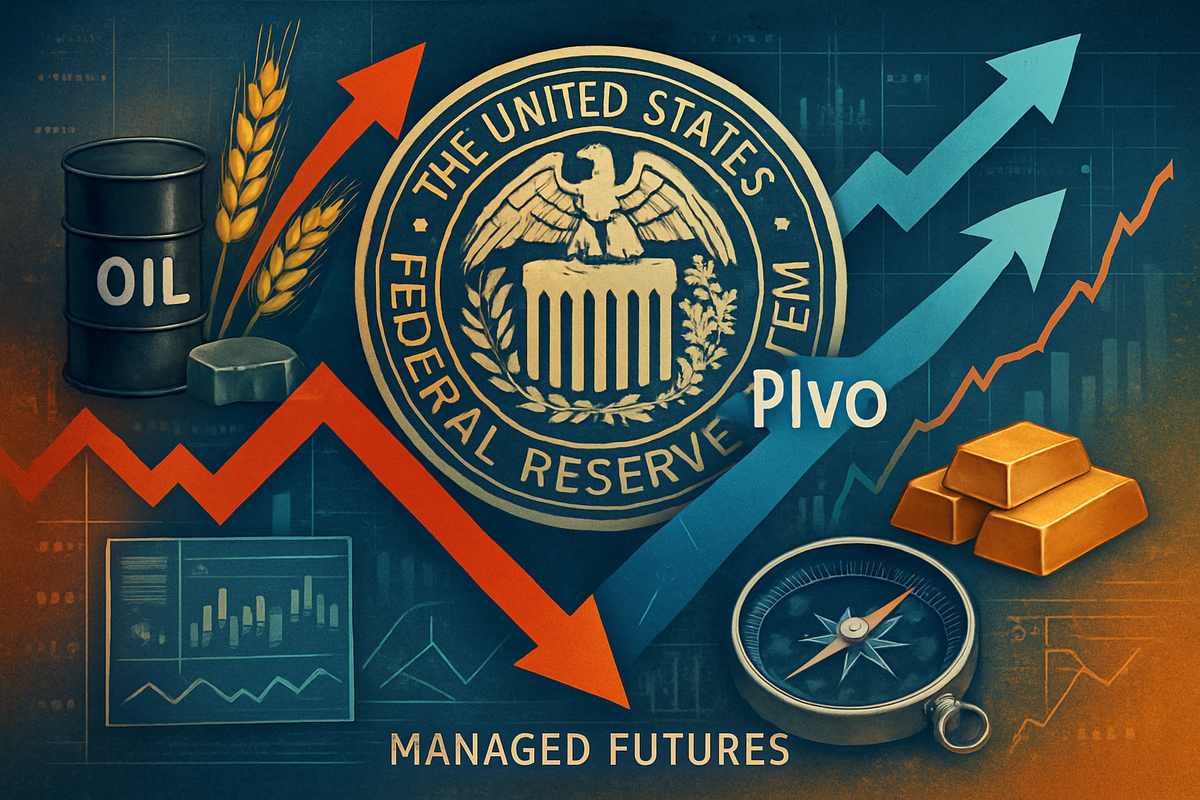
The financial markets are currently experiencing a significant shift as the Federal Reserve pivots from an aggressive monetary tightening stance to a more adaptive, easing cycle. This pivotal change, initiated with interest rate cuts in September 2025 and anticipated to continue, is reshaping the landscape for commodity futures and demanding heightened adaptability from investment vehicles like the First Trust Managed Futures Strategy ETF (NYSEARCA: FMF). Investors are now grappling with the immediate implications of a potentially weaker U.S. dollar, evolving inflation expectations, and a renewed focus on employment stability, all of which are poised to redefine market trends and investment strategies.
This strategic recalibration by the Fed introduces both opportunities and challenges, particularly for alternative investment strategies designed to thrive in dynamic environments. Managed futures, with their inherent flexibility to take long and short positions across various asset classes, are at the forefront of this transition, seeking to capitalize on the emerging trends in a post-tightening world.
The Fed's Definitive Shift: A Detailed Look at the Policy Pivot
The Federal Reserve's journey from aggressive tightening to an adaptive stance has been a carefully watched saga, culminating in a definitive pivot in late 2025. The central bank embarked on a stringent tightening cycle in March 2022, raising interest rates 11 times to combat soaring inflation, reaching a federal funds rate of 5.25%-5.50% by July 2023. This period aimed to cool an overheated economy by making borrowing more expensive.
However, signals of a change began to surface in late 2024. Federal Reserve Chair Jerome Powell hinted at a policy adjustment during the Jackson Hole Economic Symposium on August 23, 2024, citing diminished inflation risks and growing concerns over employment. The pivot became concrete in September 2025 with the first interest rate cut, lowering the federal funds rate by 0.25 percentage points to a target range of 4.0%-4.25%. Powell characterized this as a "risk management cut" to safeguard the labor market, especially after revised data revealed an overstatement of job growth over the past year. Further solidifying this adaptive posture, on October 14, 2025, Chair Powell signaled the potential conclusion of the quantitative tightening (QT) program, which had been reducing the Fed's balance sheet since 2022, indicating a move towards ensuring ample liquidity.
Key players in this monumental shift include the Federal Reserve itself, with Chair Jerome Powell's pronouncements and the Federal Open Market Committee (FOMC) decisions driving the policy. The First Trust Managed Futures Strategy ETF (NYSEARCA: FMF) represents a crucial market participant, as its performance and strategy are directly impacted by changes in interest rates and the U.S. dollar, which affect its underlying futures contracts. Participants in commodity markets, ranging from producers to traders and end-users, are also profoundly affected, as interest rate changes ripple through everything from crude oil to agricultural products.
Initial market reactions have been swift. Equity markets have seen a "ripple of optimism," with growth-oriented sectors poised to benefit from cheaper capital. Bond yields, notably the U.S. 10-Year Treasury Yield, plunged below 4% in October 2025, reflecting anticipation of an aggressive dovish pivot. The U.S. dollar is expected to weaken, a generally bullish signal for dollar-denominated commodities. Precious metals, particularly gold and silver, have soared to multi-year highs (gold past $4,200/ounce, silver nearing $52/ounce), driven by decreased opportunity cost and their role as safe-haven assets.
Corporate Fortunes in Flux: Winners and Losers from the Fed's Pivot
The Federal Reserve's pivot towards monetary easing and the subsequent shifts in commodity futures markets create a distinct delineation of potential winners and losers across various corporate sectors. This environment, characterized by lower borrowing costs and a potentially weaker U.S. dollar, directly influences input costs, demand dynamics, and investment flows.
Potential Winners:
- Commodity Producers: Companies involved in the extraction and production of raw materials are generally poised to benefit from rising commodity prices. This includes Oil and Gas Producers like Exxon Mobil (NYSE: XOM), which can see improved earnings from higher crude oil and natural gas prices. Mining Companies such as Rio Tinto (ASX: RIO) and Fortescue Metals Group (ASX: FMG) stand to gain from increased prices for iron ore, copper, and other metals. Gold producers, like Northern Star Resources (ASX: NST), are particularly favored as gold often rallies during periods of lower interest rates and economic uncertainty. Agricultural companies, such as Graincorp (ASX: GNC), could also see higher revenues from increased grain prices.
- Interest-Rate Sensitive Industries: Lower borrowing costs will reduce interest expenses for companies with high debt loads or those in capital-intensive sectors. This includes Real Estate Investment Trusts (REITs) and Residential Development firms, which benefit from lower mortgage rates stimulating housing demand. Small Businesses and Startups will find it cheaper to secure loans for expansion, fostering growth and competition. Consumer Discretionary companies may also see a boost as consumers have more disposable income due to lower debt servicing costs.
- Companies reliant on Equity Financing: Lower rates can increase investor appetite for funding, making it easier for companies to raise capital through IPOs or secondary offerings.
Potential Losers:
- Commodity Consumers (Downstream/Manufacturing): Businesses that rely on raw materials as primary inputs will face increased costs, squeezing profit margins if they cannot pass these costs on to consumers. This includes Airlines and Transportation companies, which are heavily impacted by higher fuel prices. Food Producers and Consumer Staples companies will face higher costs for agricultural commodities. The Automotive Sector could see increased costs for metals like aluminum, nickel, and lithium, impacting electric vehicle battery production.
- Companies with Weak Pricing Power: Businesses unable to effectively pass on higher input costs will see their margins erode, irrespective of lower borrowing costs.
- Fixed-Income Investments: While not companies, traditional fixed-income investments become less attractive due to lower interest rates, potentially diverting capital to other asset classes.
- Companies with USD Debt but Non-USD Revenue: A weaker U.S. dollar increases the effective debt burden for companies that have taken on USD-denominated debt but generate revenue in other, now weaker, local currencies.
The First Trust Managed Futures Strategy ETF (NYSEARCA: FMF) does not directly invest in individual companies but rather in futures contracts across various asset classes. Its strategy is designed to navigate these market conditions by:
- Dynamic Adaptation: Employing quantitative models to rapidly adapt to shifts in interest rates, commodity prices, and currency valuations, seeking out clear, persistent trends.
- Long and Short Positions: The ability to take both long (betting on price increases) and short (betting on price decreases) positions allows FMF to potentially profit whether commodity prices are rising or falling, crucial during periods of significant volatility.
- Diversification: By trading across multiple commodity types (energy, agriculture, metals), as well as currencies and interest rates, FMF aims to diversify risk and capture opportunities in different market segments.
Therefore, FMF "favors" or "disfavors" trends in commodity prices, interest rates, and currency movements. It benefits from strong, clear trends (up or down) in these markets and can struggle in choppy or range-bound conditions where trends are absent. For instance, if the Fed pivot leads to a sustained rally in agricultural commodities, FMF would likely hold long positions in agricultural futures.
Wider Significance: Reshaping the Financial Landscape
The Federal Reserve's monetary policy pivot extends far beyond immediate market reactions, fundamentally reshaping broader industry trends, creating ripple effects across global financial sectors, and potentially influencing regulatory frameworks. This shift from aggressive tightening to an adaptive stance underscores a new macroeconomic environment, drawing parallels with historical economic transitions.
This pivot reinforces the growing trend towards diversification and the quest for uncorrelated returns. In an increasingly volatile and uncertain market, investors are actively seeking alternative strategies that can provide returns independent of traditional stock and bond markets. Managed futures, like those employed by the First Trust Managed Futures Strategy ETF (NYSEARCA: FMF), are particularly relevant here, offering potential "crisis alpha"—positive returns during market downturns—and acting as a hedge against inflation through their commodity exposure. The managed futures industry itself is evolving, with some strategies now integrating "quantamental" approaches that blend quantitative analysis with fundamental data, complementing traditional trend-following in complex market conditions.
The ripple effects of the Fed's pivot are extensive. Globally, other central banks may be compelled to adjust their own monetary policies to maintain competitive currency valuations or address similar economic challenges, potentially leading to a coordinated, or at least influential, global monetary cycle. A dovish Fed typically leads to a weaker U.S. dollar, which can benefit American exports, ease the burden of dollar-denominated debt for emerging markets, and attract capital inflows to developing economies.
In equity markets, aggressive rate cuts often inject optimism, particularly benefiting interest-rate-sensitive sectors such as technology and real estate. Growth-oriented companies, whose future earnings are discounted at lower rates, become more attractive. Conversely, bond markets are likely to see plummeting yields as investors anticipate a lower future path for the federal funds rate. Real estate and housing sectors are poised to benefit significantly from lower mortgage rates. Even cryptocurrencies may find new appeal as lower interest rates make traditional investments less attractive, prompting investors to seek higher-yielding or riskier alternatives. Financial institutions, however, might face margin compression during prolonged easing cycles.
From a regulatory standpoint, a dovish pivot could signal the Fed's prioritization of employment stability, potentially tolerating temporary inflation overshoots, thereby setting new precedents for its dual mandate approach. This could also intensify scrutiny over the Fed's independence and its ability to balance price stability with maximum employment, potentially sparking discussions about structural changes or the need for a more comprehensive policy mix, including fiscal tools.
Historically, such pivots offer valuable insights. While aggressive tightening cycles in 1973, 1980, and 2022-2023 often preceded recessions, easing cycles frequently begin when the economy is already in a downturn. For instance, rate cuts during the 2008 financial crisis and the COVID-19 pandemic in 2020 were linked to surges in commodity prices. Equity markets have historically struggled in the 12 months leading up to the first rate cut, as cuts often signal economic weakness. However, after the Fed's pivot (the end of a rate hike period), the S&P 500 has historically shown more promising returns, averaging around 17% over a 12-month timeframe, with growth stocks often outperforming after the initial six months. Managed futures, notably, demonstrated double-digit returns during the dot-com bubble burst (2002), the peak of the global financial crisis (2008), and performed strongly in 2022, underscoring their ability to provide diversification during market stress.
What Comes Next: Navigating the Evolving Market Landscape
The Federal Reserve's pivot has set the stage for a dynamic period, with both short-term shifts and long-term implications for managed futures and commodity markets. Investors must prepare for various scenarios as the economy adjusts to a more adaptive monetary policy.
In the short term, a dovish Fed is likely to fuel commodity price rallies. Lower interest rates stimulate demand, and a weaker U.S. dollar makes dollar-denominated commodities more attractive globally. Goldman Sachs research suggests commodities historically rally when rates are cut in non-recessionary environments, with precious metals like gold and silver (already soaring past $4,300/ounce and nearing $52/ounce respectively) expected to continue their ascent as safe havens. However, increased volatility in futures markets is also a strong possibility as traders adjust positions based on changing inflation expectations. While initial stock market reactions to rate cuts can be mixed, historical data suggests positive returns for the S&P 500 over 3, 6, and 12 months in past cutting cycles. Managed futures strategies, with their inherent nimbleness, are designed to capture this developing price momentum.
Looking at the long term, sustained low rates could lead to prolonged periods of higher commodity prices, assuming global growth is successfully stimulated without igniting runaway inflation. The diversification benefits of managed futures, such as the First Trust Managed Futures Strategy ETF (NYSEARCA: FMF), will remain crucial, especially if traditional stock-bond correlations rise. A prolonged period of U.S. dollar weakness could also lead to a significant realignment of global currencies, impacting trade and corporate earnings.
For ETFs like FMF, strategic pivots and adaptations are paramount. Its quantitative models must dynamically adapt to new market regimes, potentially increasing long positions in trending commodities (e.g., industrial metals driven by AI demand and green energy infrastructure) and strategically positioning in currency futures to capitalize on a weaker U.S. dollar. FMF's significant commodity exposure (approximately 50%) positions it well to act as an inflation hedge if the pivot leads to persistent inflationary pressures.
Potential Market Opportunities:
- Commodity Outperformance: A dovish Fed, particularly in a non-recessionary environment, could lead to a sustained rally in various commodities, offering investment opportunities in energy, agriculture, and metals.
- Diversification and Crisis Alpha: Managed futures ETFs like FMF can offer true diversification and potential "crisis alpha" during market downturns, providing positive returns when traditional assets struggle.
- Emerging Market Inflows: A weaker U.S. dollar and improved global sentiment could redirect capital towards higher-yielding emerging markets.
Potential Challenges:
- Economic Slowdown/Recession: If the Fed's pivot is a reaction to a deteriorating economy, industrial commodities might face downward pressure due to reduced demand.
- Persistent Inflation: If inflation remains stubbornly high despite rate cuts, it could challenge traditional portfolios and force the Fed into a difficult balancing act.
- Increased Volatility: Heightened volatility in futures markets can lead to increased margin requirements and potential market instability.
- Underperformance in Range-Bound Markets: Managed futures thrive on trends, so prolonged periods of directionless price action could be challenging.
Various Scenarios and Outcomes for Investors:
- Soft Landing: The Fed successfully curtails inflation without a deep recession. Outcomes: Moderate, sustained gains in commodities, continued positive performance for FMF by capturing trends, and overall positive returns for balanced portfolios.
- Recession: The Fed's cuts are a response to a significant economic downturn. Outcomes: Industrial commodities face downward pressure; precious metals rally as safe havens; FMF leverages short positions, providing "crisis alpha" and downside protection for portfolios.
- Stagflation: Low growth combined with persistent inflation. Outcomes: Gold and other inflation-hedging commodities rally; FMF is well-positioned to go long on rising commodity prices and potentially short assets negatively impacted by stagflation; traditional portfolios struggle.
- Unexpected Hawkish Reversal: The Fed is forced to tighten again due to reaccelerating inflation. Outcomes: Commodities face downward pressure; FMF pivots its strategy to short underperforming assets and potentially go long on assets benefiting from a stronger dollar; significant volatility for risk assets.
Comprehensive Wrap-Up: Navigating the New Monetary Era
The Federal Reserve's monetary policy pivot in late 2025 marks a critical juncture, ushering in a new era for financial markets. This shift from aggressive tightening to a more adaptive, easing stance is characterized by interest rate cuts and a re-evaluation of economic priorities, with profound implications for the First Trust Managed Futures Strategy ETF (NYSEARCA: FMF) and the broader commodity futures markets.
Key Takeaways: The Fed's decision to cut rates, driven by a softening labor market and an uneven battle against inflation, signals a prioritization of employment stability. This pivot has already led to a depreciation of the U.S. dollar and a significant decline in Treasury yields, while precious metals like gold and silver have experienced historic rallies. The First Trust Managed Futures Strategy ETF (FMF), with its substantial allocation to commodity futures (approximately 50%), is strategically positioned to navigate these changes. Its active, trend-following approach allows it to take both long and short positions, theoretically enabling it to profit from emerging trends in commodity prices, currency fluctuations, and interest rate movements. While FMF's recent year-to-date returns reflect the complexity of this transition period, its design is inherently suited for dynamic market environments.
Market Assessment Moving Forward: The market is largely pricing in a continued easing cycle, fostering a "risk-on" sentiment for equities, particularly growth-oriented sectors. However, the Fed faces a delicate balancing act: stimulating growth without reigniting inflation. This creates an environment of volatility and uncertainty, where divergence between market expectations and FOMC projections will be a key driver of sentiment. A persistently weaker U.S. dollar is broadly anticipated, which will continue to support dollar-denominated assets.
Lasting Impact: The Fed's pivot is poised to have several lasting impacts. It underscores a central bank prioritizing employment stability, potentially setting a new precedent for its dual mandate. This will likely lead to a significant reallocation of capital flows, moving from traditional money market funds into alternative investments and towards higher-yielding emerging markets. The long-run economic trajectory will be shaped by how effectively this easing calibrates policy for sustained growth. Furthermore, the delicate balancing act the Fed is undertaking will likely intensify scrutiny on central banks globally.
What Investors Should Watch For: In the coming months, investors must remain vigilant. Closely monitor Federal Reserve communications, including FOMC minutes and speeches from officials, for clues on the pace and magnitude of future rate cuts. Pay critical attention to economic data releases, particularly labor market figures, inflation gauges (CPI, PCE), and manufacturing indices. The U.S. Dollar Index (DXY) will remain a crucial indicator for commodity price movements. Geopolitical developments (e.g., U.S.-China tensions, tariffs) and commodity-specific fundamentals (supply/demand dynamics) will also play significant roles. Finally, observe FMF's performance and adaptation—how its managed futures strategies effectively identify and capitalize on the evolving trends arising from the interplay of monetary policy, commodity prices, and currency fluctuations. In this new monetary era, agile and diversified strategies like managed futures will be crucial for navigating the opportunities and challenges ahead.
This content is intended for informational purposes only and is not financial advice





